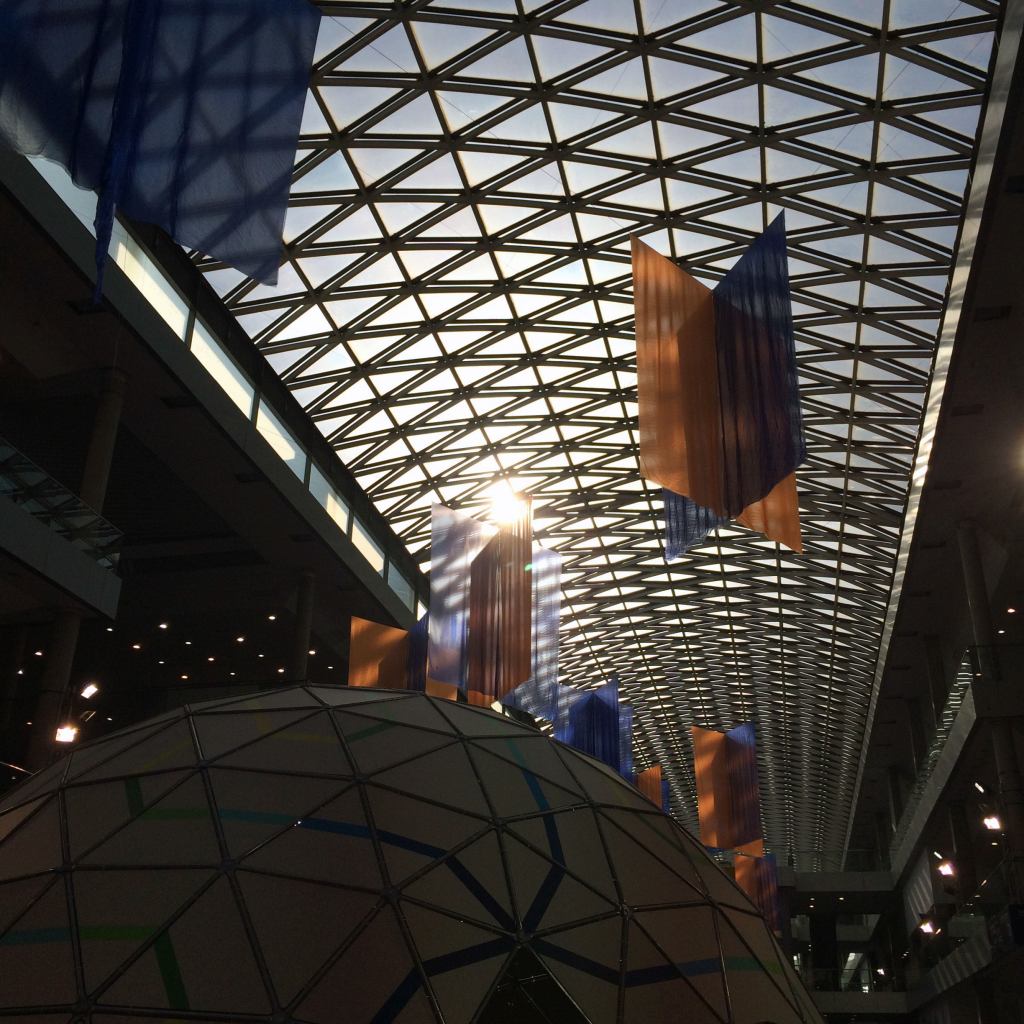The design and production of ceramic tile are endemic to Spain, and the craftsmanship of the historical enterprise is visible from the floors and walls of the historic Alhambra in Granada to the halls of ceramic tile displayed at the annual Cevisama trade show, held last week in Valencia, Spain. Joining a media tour led by Tile of Spain, which represents 125 of the country’s tile makers in the U.S., ARCHITECT saw the latest products and trends from some of the global leaders in the market. Here are a few that caught our eye:
Large Slabs Made Thinner
Sintering technology allows manufacturers to create ceramic slabs that are larger and thinner than their predecessors without compromising durability. For use as exterior cladding, counters, and more, these compact surfaces weigh less by volume, making them easier to move to and around the jobsite.
Inalco featured its Itopker porcelain slabs in a new 59-inch-wide-by-118-inch-long format that can be used in applications such as countertops with built-in kitchen ranges as the proprietary material does not conduct heat or absorb much water and resists stains. Neolith’s similarly sintered surfacing, The Size, added new colors (Iron Ash, below) to its metal-inspired series that are digitally printed to convey the intricacies of iron, copper, and more.
Texture, Pressed and Printed
In Craft, Peronda partnered with studio Joan Rojeski, in Castellón, Spain, to create the look of handmade recycled paper on ceramic. The team sourced waste paper from Peronda’s closed-loop factory and offices to create a recycled paper relief whose image was digitally scanned and printed on the pressed surface, replicating the fine visual and physical textures of the original paper. Though the company admits that the product isn’t eco-friendly, it plans to work with the World Wildlife Fund to plant a tree for every 10 square meters of the tile sold.
While the glut of digitally printed wood ceramics on the market can be exhausting, Vives Ceramica is invigorating the concept with its World Woods series. Measuring 7.8 inches wide by 47.2 inches long, the six pressed porcelain floor and wall tiles represent wood species and designs from around the globe. Among them, Okinawa emulates the Japanese technique of carbonizing wood for a charred effect, which is achieved here with a rich, printed finish and tangible surface grooves.
Colorfast Contemporary Geometries
Hexagons didn’t shirk from the spotlight at this tile show. Natucer debuted its 3D Hex series of three-dimensional wall and two-dimensional floor tiles in eye-popping glossy and subdued matte finishes.
Also joining the lineup of bold shapes was Valencia, Spain–based studio Mut Design’s take on squares. With two raised edges in vibrant neon hues, the 4.7-inch-square tiles that make up the Scales collection joins Peronda’s Harmony line with a color palette that includes bright red, blue, pink, green, and a glossy black and that glow across the glazed surface.
Subway tiles, with their characteristic beveled edge, aren’t new but nonetheless were a visible trend on the show floor. Among them, Roca’s Botania series offered a contemporary spin on the pattern in the form of neutral-toned porcelain planks measuring 5.9 inches wide by 35.4 inches long.
Mosaic Accents for All Occasions
Spain is no stranger to mosaics. Saloni’s pressed Sunset series offers the look of one without the painstaking installation in the form of 15.7-inch-wide-by-47.2-inch-long white-body ceramic slabs for the walls and 23.6-inch porcelain squares for the floor. Designs include ridges, shingles, and petals (shown) in both monolithic and minimally contrasting neutral hues.
In its Allegra series, Roca offers mesh-mounted mosaic squares and 9.8-inch-tall-by-27.6-inch-wide, white-body, ceramic plank wall tiles in nine saturated colors that suit them best for use as accents and backsplashes.
And in Togama‘s Gea, a textured glass mosaic, metallic finishes render replications of geological forms such as rocks, sand dunes, and volcanic craters as subtle details that shimmer on the wall. The material contains 100 percent post-consumer-recycled float glass obtained from deconstructed civic and commercial buildings.
The Never-Ending Quest to Replicate Stone
Inalco’s Touché 1.0, which debuted last fall at the Cersaie ceramic tradeshow in Bologna, Italy, was showcased for its use of the company’s novel Blanco Plus+ coloring to enhance the marbled effect of the printed surface with an ultra-white background. At 6 millimeters thick, the slabs are offered in 40-inch squares.
Vulcano by Ceracasa creates a soft slate look from porcelain. Offered with rectified edges for precise installation, the tiles can be used indoors and outdoors. A 0.5-millimeter- to 1-millimeter-relief adds non-intrusive texture while mimicking stone’s texture.
